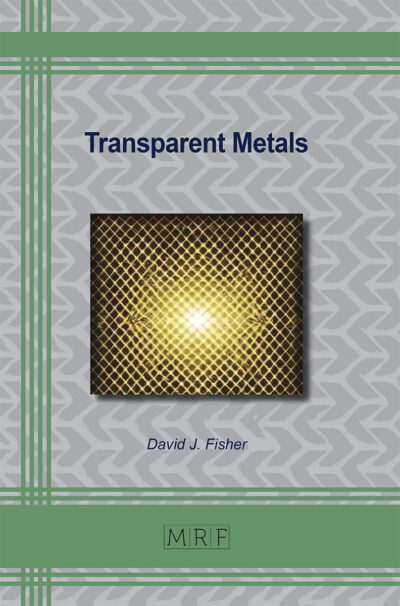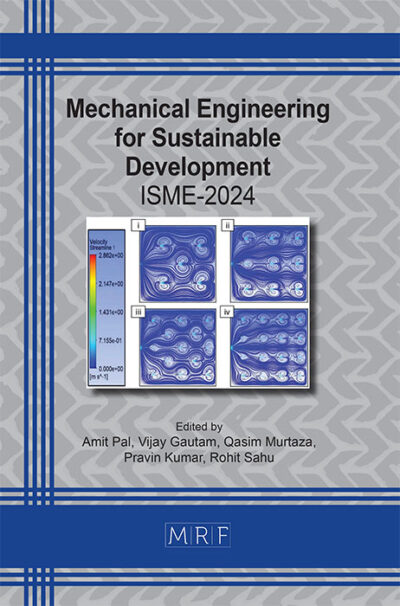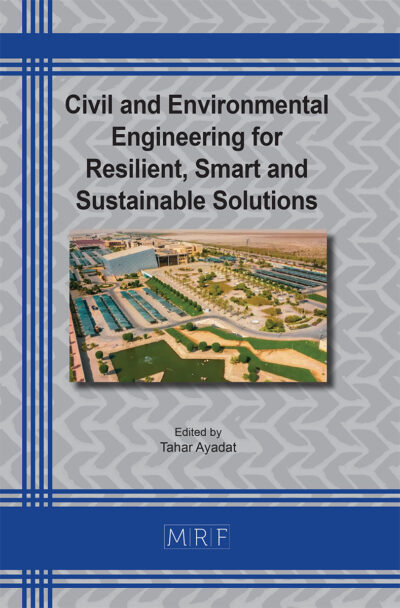Investigation of the density, ultrasonic pulse velocity and strength properties of metakaolin based geopolymer mortars
Layal HAWA, Jamal KHATIB, Mohamad Ezzedine EL DANDACHY
Abstract. Ordinary Portland Cement (OPC) remains a cornerstone of construction, but its production carries a significant environmental burden due to greenhouse gas emissions. This paper investigates Metakaolin-based geopolymer mortar (GPM) as a promising replacement for OPC mortars, focusing on its potential for reduced environmental impact. The study explores the influence of two main factors on the properties of geopolymer mortar: the Alkaline to Metakaolin ratio (A/M) and the Sodium Silicate to Sodium Hydroxide solution ratio (SS/SH). The molarity of sodium hydroxide was fixed at 16 for all samples, and the curing temperature was maintained at 60°C for 24 hours after demolding. The effect of these variations on the unit weight, ultrasonic pulse velocity, and compressive strength of the geopolymer mortar was evaluated. Notably, geopolymer mortars have been shown to exhibit compressive strengths exceeding those of traditional OPC mortars. The investigation focuses on the interplay between A/M and SS/SH ratios. A higher A/M ratio, with a higher amount of alkaline activator in the mix, can enhance the mechanical properties of geopolymer mortars. Moreover, the additional alkalinity promotes further geopolymerization and the formation of crystalline materials within the geopolymer structure, ultimately leading to improved strength. However, maintaining a controlled amount of silica is crucial. While sodium silicate is a necessary component of the activator solution, an excessive amount of soluble silicate can hinder the formation of these geopolymer mortars for achieving desired mechanical properties and durability while contributing to the development of more sustainable construction materials. The findings will highlight the delicate balance between the A/M and SS/SH ratios for maximizing the potential of geopolymer mortars as a viable and environmentally friendly alternative to traditional cement-based materials.
Keywords
Metakaolin, Geopolymer Mortar, Alkaline Activator, Mechanical Properties
Published online 2/25/2025, 9 pages
Copyright © 2025 by the author(s)
Published under license by Materials Research Forum LLC., Millersville PA, USA
Citation: Layal HAWA, Jamal KHATIB, Mohamad Ezzedine EL DANDACHY, Investigation of the density, ultrasonic pulse velocity and strength properties of metakaolin based geopolymer mortars, Materials Research Proceedings, Vol. 48, pp 350-358, 2025
DOI: https://doi.org/10.21741/9781644903414-39
The article was published as article 39 of the book Civil and Environmental Engineering for Resilient, Smart and Sustainable Solutions
![]() Content from this work may be used under the terms of the Creative Commons Attribution 3.0 license. Any further distribution of this work must maintain attribution to the author(s) and the title of the work, journal citation and DOI.
Content from this work may be used under the terms of the Creative Commons Attribution 3.0 license. Any further distribution of this work must maintain attribution to the author(s) and the title of the work, journal citation and DOI.
References
[1] Krour, H., Tazi, N., Trauchessec, R., Fraj, A. B., Lecomte, A., Idir, R., Barnes-Davin, L., Bolze, B., & Delhay, A. (2022). Industrial-scale valorization of fine recycled aggregates in cement raw meal: Towards sustainable mixtures. Journal of Cleaner Production, 362, 132231. https://doi.org/10.1016/j.jclepro.2022.132231
[2] Dinga, C. D., & Wen, Z. (2022). China’s green deal: Can China’s cement industry achieve carbon neutral emissions by 2060? Renewable & Sustainable Energy Reviews, 155, 111931. https://doi.org/10.1016/j.rser.2021.111931
[3] Davidovits, J. (1991). Geopolymers. Journal of Thermal Analysis, 37(8), 1633–1656. https://doi.org/10.1007/bf01912193
[4] Davidovits, J., Comrie, D. C., Paterson, J. H., & Ritcey, D. J. (1990). Geopolymeric concretes For Environmental Protection. Concrete International, 12(7), 30–40. https://www.concrete.org/publications/internationalconcreteabstractsportal/m/details/id/9511
[5] Liu, X., Jiang, J., Zhang, H., Li, M., Wu, Y., Guo, L., Wang, W., Duan, P., Zhang, W., & Zhang, Z. (2020). Thermal stability and microstructure of metakaolin-based geopolymer blended with rice husk ash. Applied Clay Science, 196, 105769. https://doi.org/10.1016/j.clay.2020.105769
[6] Diffo, B. B. K., Elimbi, A., Cyr, M., Manga, J. D. & Kouamo, H. T. (2015). Effect of the rate of calcination of kaolin on the properties of metakaolin-based geopolymers. Journal of Asian Ceramic Societies, 3(1), 130–138. https://doi.org/10.1016/j.jascer.2014.12.003
[7] Liew, Y., Kamarudin, H., Bakri, A. M. A., Binhussain, M., Luqman, M., Nizar, I. K., Ruzaidi, C., & Heah, C. (2011). Influence of solids-to-liquid and activator ratios on calcined kaolin cement powder. Physics Procedia, 22, 312–317. https://doi.org/10.1016/j.phpro.2011.11.049
[8] Jindal, B., Alomayri, T., Hasan, A., & Kaze, C. R. (2022). Geopolymer concrete with metakaolin for sustainability: a comprehensive review on raw material’s properties, synthesis, performance, and potential application. https://doi.org/10.1007/s11356-021-17849 w
[9] Provis, J., Duxson, P., Van Deventer, J., & Lukey, G. (2005). The role of mathematical modelling and gel chemistry in advancing geopolymer technology. Process Safety and Environmental Protection/Transactions of the Institution of Chemical Engineers. Part B, Process Safety and Environmental Protection/Chemical Engineering Research and Design/Chemical Engineering Research & Design, 83(7), 853 860. https://doi.org/10.1205/cherd.04329
[10] Albidah, A., Alghannam, M., Abbas, H., Almusallam, T., & Al-Salloum, Y. (2021). Characteristics of metakaolin-based geopolymer concrete for different mix design parameters. Journal of Materials Research and Technology/Journal of Materials Research and Technology, 10, 84–98. https://doi.org/10.1016/j.jmrt.2020.11.104
[11] Zhang, P., Zheng, Y., Wang, K., & Zhang, J. (2018). A review on properties of fresh and hardened geopolymer mortar. Composites. Part B, Engineering, 152, 79–95. https://doi.org/10.1016/j.compositesb.2018.06.031
[12] Liew, Y., Kamarudin, H., Bakri, A. M. A., Binhussain, M., Luqman, M., Nizar, I. K., Ruzaidi, C., & Heah, C. (2011). Influence of solids-to-liquid and activator ratios on calcined kaolin cement powder. Physics Procedia, 22, 312–317. https://doi.org/10.1016/j.phpro.2011.11.049
[13] Supit, S. W., & Olivia, M. (2022). Compressive strength and sulfate resistance of metakaolin-based geopolymer mortar with different ratio of alkaline activator. Materials Today: Proceedings, 66, 2776–2779. https://doi.org/10.1016/j.matpr.2022.06.514
[14] ASTM International C150/C150M – 20. Standard Specification for Portland Cement. https://doi.org/10.1520/C0150_C0150M-20
[15] ASTM International C33/C33M – 18. Standard Specification for Concrete Aggregates. https://doi.org/10.1520/C0033_C0033M-18
[16] ASTM International C642/ C642M – 06. Standard Test Method for Density, Absorption, and Voids in Hardened Concrete. https://doi.org/10.1520/C0642_C0642M-06
[17] ASTM International C597/ C597M – 16. Standard Test Method for Pulse Velocity Through Concrete. https://doi.org/10.1520/C0597_C0597M-16
[18] ASTM International C109 / C109M – 20. Standard Test Method for Compressive Strength of Hydraulic Cement Mortars. https://doi.org/10.1520/C0109_C0109M-20












